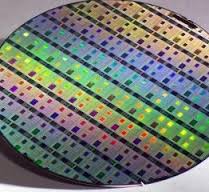Commonly used semiconductor materials
The example of semiconductor materials are germanium (Ge), silicon (Si), carbon (C), selenium (Se), gallium arsenide (GaAs), cadmium sulphide (CdS) etc.
A large number of semiconductor materials are known, but the most frequently used in practice are germanium and silicon. It is because the energy to required to break their covalent bonds is small, being 0.72 eV for germanium and 1.11 eV for silicon.
- Germanium : It has become the model substance among the semiconductor materials because it can be purified relatively well and crystallised easily. It is an earth element and was discovered in 1896 A.D. Pure germanium is recovered from the ash of certain coals or from the flue dust of zinc smelters. Generally, the recovered germanium is in the form of germanium dioxide powder which is then reduced to pure germanium. It is a tetravalent element and has a crystalline structure.
- Silicon : It is the most practically used semiconductor material for all solid state devices. It is available in most of the common rocks. Actually, sand is silicon dioxide. The silicon compounds are chemically reduced to 100% pure silicon to be used as a semiconductor. It is also a tetravalent element and has a crystalline structure.

